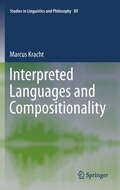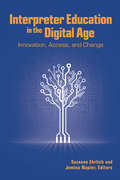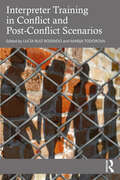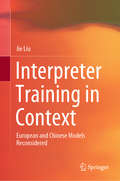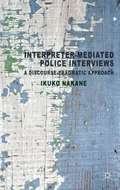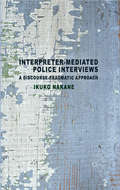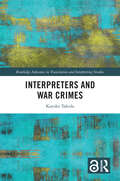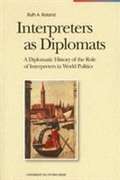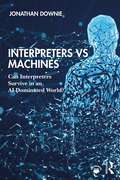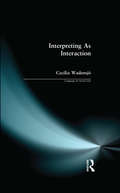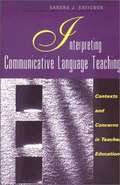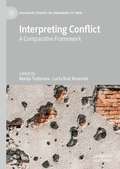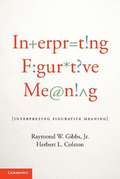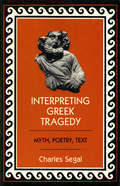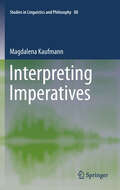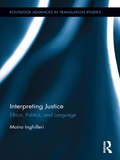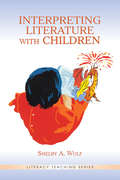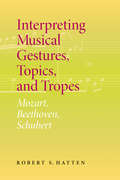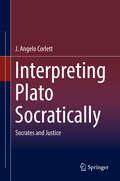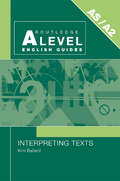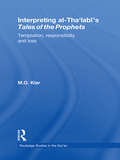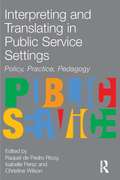- Table View
- List View
Interpretations of History: From Confucius to Toynbee (Routledge Library Editions: Historiography)
by Alban G. WidgeryIn this volume, originally published in 1961, the author presents an exposition of the meanings given to history. Part 1 describes the conceptions of history impied in wide-spread religions and cultures, Confucian and Taoist, Hindu and Buddhist, Zoroastrian and Muslim, Greek and Roman, Jewish and Christian. Part 2 surveys the theories of independent thinkers and schools in the Occident from the Middle Ages to the mid-twentieth century.
Interpreted Languages and Compositionality
by Marcus KrachtThis book argues that languages are composed of sets of 'signs', rather than 'strings'. This notion, first posited by de Saussure in the early 20th century, has for decades been neglected by linguists, particularly following Chomsky's heavy critiques of the 1950s. Yet since the emergence of formal semantics in the 1970s, the issue of compositionality has gained traction in the theoretical debate, becoming a selling point for linguistic theories. Yet the concept of 'compositionality' itself remains ill-defined, an issue this book addresses. Positioning compositionality as a cornerstone in linguistic theory, it argues that, contrary to widely held beliefs, there exist non-compositional languages, which shows that the concept of compositionality has empirical content. The author asserts that the existence of syntactic structure can flow from the fact that a compositional grammar cannot be delivered without prior agreement on the syntactic structure of the constituents.
Interpreter Education in the Digital Age: Innovation, Access, and Change
by Jemina Napier Suzanne EhrlichThis collection brings together innovative research and approaches for blended learning using digital technology in interpreter education for signed and spoken languages. Volume editors Suzanne Ehrlich and Jemina Napier call upon the expertise of 21 experts, including themselves, to report on the current technology used to provide digital enhancements to interpreter education in Australia, New Zealand, Brazil, Belgium, the United Kingdom, and the United States. Divided into three parts, Innovation, Change, and Community Engagement, this study focuses on the technology itself, rather than how technology enhances curriculum, delivery, or resources. Initiatives described in this collection range from the implementation of on-demand interpreting using iPad technology to create personalized, small-group, multidimensional models suited to digital media for 160 languages; introducing students to interpreting in a 3D world through an IVY virtual environment; applying gaming principles to interpreter education; assessing the amenability of the digital pen in the hybrid mode of interpreting; developing multimedia content for both open access and structured interpreter education environments; to preparing interpreting students for interactions in social media forums, and more. Interpreter Education in the Digital Age provides a context for the application of technologies in interpreter education from an international viewpoint across languages and modalities.
Interpreter Training in Conflict and Post-Conflict Scenarios
by Marija Todorova Lucía Ruiz RosendoThe role of interpreters in conflict situations is of increasing real world importance. There are ethical, cultural and professional issues that have yet to be explored and there is a need for specialised training that addresses the specific contexts in which interpreters perform their duties, considering the situated nature of interpreting in these contexts. This volume is structured around interpreter training in different contexts of conflict and post-conflict, from military operations and international tribunals to asylum-seeking and refugee, humanitarian and human rights missions. Themes covered include risk management and communication, ethics and professional demeanour, language technology and its use, intercultural mediation, training in specific contexts, such as conflict resolution and negotiation, and working with trauma. Chapters are authored by experts from around the world with a range of different profiles: military personnel, scholars, the staff of international organisations, and representatives from refugee and asylum-seeker-assisting institutions. Interpreter Training in Conflict and Post-Conflict Scenarios is key reading both for students and scholars researching interpreting in conflict zones and conflict-related scenarios and for practising and trainee interpreters and mediators working for international organisations and the military.
Interpreter Training in Context: European and Chinese Models Reconsidered
by Jie LiuThis book addresses an important, yet under-researched domain in interpreting education: how theoretical training models should be responsive to context. To do so, it applies the linguistic concept of ‘context’ to interpreting studies by investigating practices in representative (conference) interpreting training programmes in Europe and China. After presenting an overview of interpreter training programmes, the author describes the need to reassess the applicability of the well-established and widely accepted model of interpreting from the Paris School (ESIT/AIIC model) to the Chinese interpreting training scene.Building on the theoretical study of context in foreign language classrooms suggested by linguists like Halliday and Hasan (1993); Kramsch (1993) and others, the author subsequently constructs a new curriculum, comprising a four-step approach to consecutive interpreting courses in the Chinese context. The rationale for such an approach is justified in accordance with the overall design of context, taking into account the four dimensions in a teaching–learning environment.This book is intended for scholars and graduate students who are interested in translation and interpreting, applied linguistics as well as foreign language education. It also serves as a practical guide for developing (university-level) translation and interpreting programmes.
Interpreter-mediated Police Interviews
by Ikuko NakaneThis book shows how the participation of interpreters as mediators changes the dynamics of police interviews, particularly with regard to power struggles and competing versions of events. Employing a range of approaches including conversation analysis, interactional sociolinguistics and legal narrative theory, Interpreter-mediated Police Interviews provides a detailed study of the impact of interpreter mediation on this area of the justice system. It reveals how turn-by-turn decisions of communication by all three participants, including the interpreter, affect the trajectory of the institutional discourse. By providing a better understanding of police interview discourse and exploring the practical implications of interpreter participation, this book contributes to the improvement of interpreter-mediated investigative interviews and will be of great interest to legal professionals as well as interpreters and their trainers.
Interpreter-mediated Police Interviews: A Discourse-Pragmatic Approach
by I. NakaneThis book shows how participation of interpreters as mediators changes the dynamics of police interviews, particularly with regard to power struggles and competing versions of events. The analysis of interaction offers insights into language in the legal process.
Interpreters and War Crimes (Routledge Advances in Translation and Interpreting Studies)
by Kayoko TakedaTaking an interdisciplinary approach, this book raises new questions and provides different perspectives on the roles, responsibilities, ethics and protection of interpreters in war while investigating the substance and agents of Japanese war crimes and legal aspects of interpreters’ taking part in war crimes. Informed by studies on interpreter ethics in conflict, historical studies of Japanese war crimes and legal discussion on individual liability in war crimes, Takeda provides a detailed description and analysis of the 39 interpreter defendants and interpreters as witnesses of war crimes at British military trials against the Japanese in the aftermath of the Pacific War, and tackles ethical and legal issues of various risks faced by interpreters in violent conflict. The book first discusses the backgrounds, recruitment and wartime activities of the accused interpreters at British military trials in addition to the charges they faced, the defence arguments and the verdicts they received at the trials, with attention to why so many of the accused were Taiwanese and foreign-born Japanese. Takeda provides a contextualized discussion, focusing on the Japanese military’s specific linguistic needs in its occupied areas in Southeast Asia and the attributes of interpreters who could meet such needs. In the theoretical examination of the issues that emerge, the focus is placed on interpreters’ proximity to danger, visibility and perceived authorship of speech, legal responsibility in war crimes and ethical issues in testifying as eyewitnesses of criminal acts in violent hostilities. Takeda critically examines prior literature on the roles of interpreters in conflict and ethical concerns such as interpreter neutrality and confidentiality, drawing on legal discussion of the ineffectiveness of the superior orders defence and modes of individual liability in war crimes. The book seeks to promote intersectoral discussion on how interpreters can be protected from exposure to manifestly unlawful acts such as torture.
Interpreters as Diplomats: A Diplomatic History of the Role of Interpreters in World Politics
by Ruth A. RolandThis book looks at the role played throughout history by translators and interpreters in international relations. It considers how political linguistics function and have functioned throughout history.
Interpreters vs Machines: Can Interpreters Survive in an AI-Dominated World?
by Jonathan DownieFrom tech giants to plucky startups, the world is full of companies boasting that they are on their way to replacing human interpreters, but are they right? Interpreters vs Machines offers a solid introduction to recent theory and research on human and machine interpreting, and then invites the reader to explore the future of interpreting. With a foreword by Dr Henry Liu, the 13th International Federation of Translators (FIT) President, and written by consultant interpreter and researcher Jonathan Downie, this book offers a unique combination of research and practical insight into the field of interpreting. Written in an innovative, accessible style with humorous touches and real-life case studies, this book is structured around the metaphor of playing and winning a computer game. It takes interpreters of all experience levels on a journey to better understand their own work, learn how computers attempt to interpret and explore possible futures for human interpreters. With five levels and split into 14 chapters, Interpreters vs Machines is key reading for all professional interpreters as well as students and researchers of Interpreting and Translation Studies, and those with an interest in machine interpreting.
Interpreting As Interaction (Language In Social Life)
by Cecilia WadensjoInterpreting in Interaction provides an account of interpreter-mediated communication, exploring the responsibilities of the interpreter and the expectations of both the interpreter and of other participants involved in the interaction. The book examines ways of understanding the distribution of responsibility of content and the progression of talk in interpreter-mediated institutional face-to-face encounters in the community interpreting context.Bringing attention to discursive and social practices prominent in modern society but largely unexplored in the existing literature, the book describes and explains real-life interpreter-mediated conversations as documented in various public institutions, such as hospitals and police stations. The data show that the interpreter's prescribed role as a non-participating, non-person does not -and cannot - always hold true. The book convincingly argues that this in one sense exceptional form of communication can be used as a magnifying glass in the grounded study of face-to-face institutional interaction more generally.Cecilia Wadensjö explains and applies a Bakhtinian dialogic theory of language and mind, and offers an alternative understanding of the interpreter's task, as one consisting of translating and co-ordinating, and of the interpreter as an engaged actor solving problems of translatability and problems of mutual understanding in situated social interactions.Teachers and students of translation and interpretation studies, including sign language interpreting, applied linguistics and sociolinguistics will welcome this text. Students and professionals within law, medicine and education will also find the study useful to help them understand the role of the interpreter within these frameworks.
Interpreting Communicative Language Teaching: Contexts and Concerns in Teacher Education
by Sandra J. SavignonThe emergence of English as a global language, along with technological innovations and the growing need for learner autonomy, is changing language teaching rapidly and profoundly. With these changes come new demands and challenges for teaching education programs. This authoritative collection of writings highlights some of the best work being done today in the United States and abroad to make communicative competence an attainable goal. The contributors examine what has come to be known as communicative language teaching, or CLT, from the perspectives of teachers and teacher educators. The book documents current reform initiatives in Japan, the United States, Hong Kong, Taiwan, and continental Europe to provide a global perspective on language teaching for communicative competence. Four major themes recur throughout the volume: the multifaceted nature of language teaching; the highly contextualized nature of CLT; the futility of defining a "native speaker" in the postcolonial, postmodern world; and the,overwhelming influence of high-stakes tests on language teaching. The book is a useful and valuable tool for language teachers, teacher educators, and policymakers.
Interpreting Conflict: A Comparative Framework (Palgrave Studies in Languages at War)
by Marija Todorova Lucía Ruiz RosendoThis edited book examines the role of interpreting in conflict situations, bringing together studies from different international and intercultural contexts, with contributions from military personnel, humanitarian interpreters and activists as well as academics. The authors use case studies to compare relevant notions of interpreting in conflict-related scenarios such as: the positionality of the interpreter, the ethical, emotional and security implications of their work, the specific training needed to carry out work for military and humanitarian organizations, and the relations of power created between the different stakeholders. The book will be of interest to students and scholars of translation and interpreting, conflict and peace studies, as well as conflict resolution and management.
Interpreting Figurative Meaning
by Herbert L. Colston Raymond W. Gibbs Jr.Interpreting Figurative Meaning critically evaluates the recent empirical work from psycholinguistics and neuroscience examining the successes and difficulties associated with interpreting figurative language. There is now a huge, often contradictory literature on how people understand figures of speech. Gibbs and Colston argue that there may not be a single theory or model that adequately explains both the processes and products of figurative meaning experience. Experimental research may ultimately be unable to simply adjudicate between current models in psychology, linguistics and philosophy of how figurative meaning is interpreted. Alternatively, the authors advance a broad theoretical framework, motivated by ideas from "dynamical systems theory," that describes the multiple, interacting influences which shape people's experiences of figurative meaning in discourse. This book details past research and theory, offers a critical assessment of this work, and sets the stage for a new vision of figurative experience in human life.
Interpreting Greek Tragedy: Myth, Poetry, Text
by Charles SegalThis generous selection of published essays by the distinguished classicist Charles Segal represents over twenty years of critical inquiry into the questions of what Greek tragedy is and what it means for modern-day readers. Taken together, the essays reflect profound changes in the study of Greek tragedy in the United States during this period-in particular, the increasing emphasis on myth, psychoanalytic interpretation, structuralism, and semiotics.
Interpreting Imperatives
by Magdalena KaufmannImperative clauses are recognized as one of the major clause types alongside those known as declarative and interrogative. Nevertheless, they are still an enigma in the study of meaning, which relies largely on either the concept of truth conditions or the concept of information growth--neither of which are easily applied to imperatives. This book puts forward a fresh perspective. It analyzes imperatives in terms of modalized propositions, and identifies an additional, presuppositional, meaning component that makes an assertive interpretation inappropriate. The author shows how these two elements can help explain the varied effects imperatives have, depending on their usage context. Imperatives have been viewed as elusive components of language because they have a range of functions that makes them difficult to unify theoretically. This fresh view of the semantics-pragmatics interface allows for a uniform semantic analysis while accounting for the pragmatic versatility of imperatives.
Interpreting Justice: Ethics, Politics and Language (Routledge Advances in Translation and Interpreting Studies)
by Moira InghilleriIn this timely study, Inghilleri examines the interface between ethics, language, and politics during acts of interpreting, with reference to two particular sites of transnational conflict: the political and judicial context of asylum adjudication and the geo-political context of war. The book characterizes the social and moral spaces in which the translation of the spoken word occurs in ways that reflect the realities of the trans-nationally constituted, locally and globally informed environments in which interpreters work alongside others. One of the core arguments is that the rather restricted notion of neutrality that remains central to translator and interpreter practices does not adequately reflect the complex and paradoxical nature of these socially and politically inscribed encounters and others like them. This study offers an alternative theoretical perspective on language and ethics to those which have shaped and informed translation and interpreting theory and practice in recent years.
Interpreting Literature With Children (Literacy Teaching Series)
by Shelby A. WolfClearly organized and beautifully written, Interpreting Literature With Children is a remarkable book that stands on the edge of two textbook genres: the survey of literature text and the literary criticism text. Neither approach, however, says enough about how children respond to literature in everyday classroom situations. That is the mission of this book. It begins by providing a solid foundation in both approaches and then examines multiple ways of developing children's literary interpretation through talk, through culture, class, and gender, as well as through creative modes of expression, including writing, the visual arts, and drama. The result is a balanced resource for teachers who want to deepen their understanding of literature and literary engagement. Because of its modest length and price and its ongoing focus on how to increase student engagement with literature, either pre-service or practicing teachers can use this text in children's literature, language arts, or literacy and language courses.
Interpreting Musical Gestures, Topics, and Tropes: Mozart, Beethoven, Schubert
by Robert S. HattenRobert Hatten’s new book is a worthy successor to his Musical Meaning in Beethoven, which established him as a front-rank scholar... in questions of musical meaning.... [B]oth how he approaches musical works and what he says about them are timely and to the point. Musical scholars in both musicology and theory will find much of value here, and will find their notions of musical meaning challenged and expanded." —Patrick McCrelessThis book continues to develop the semiotic theory of musical meaning presented in Robert S. Hatten’s first book, Musical Meaning in Beethoven (IUP, 1994). In addition to expanding theories of markedness, topics, and tropes, Hatten offers a fresh contribution to the understanding of musical gestures, as grounded in biological, psychological, cultural, and music-stylistic competencies. By focusing on gestures, topics, tropes, and their interaction in the music of Mozart, Beethoven, and Schubert, Hatten demonstrates the power and elegance of synthetic structures and emergent meanings within a changing Viennese Classical style.Musical Meaning and Interpretation—Robert S. Hatten, editor
Interpreting Plato Socratically: Socrates And Justice
by J. Angelo CorlettJ. Angelo Corlett’s new book, Interpreting Plato Socratically continues the critical discussion of the Platonic Question where Corlett’s book, Interpreting Plato’s Dialogues concluded. New arguments in favor of the Mouthpiece Interpretation of Plato’s works are considered and shown to be fallacious, as are new objections to some competing approaches to Plato’s works.The Platonic Question is the problem of how to approach and interpret Plato’s writings most of which are dialogues. How, if at all, can Plato’s beliefs, doctrines, theories and such be extracted from dialogues where there is no direct indication from Plato that his own views are even to be found therein? Most philosophers of Plato attempt to decipher from Plato’s texts seemingly all manner of ideas expressed by Socrates which they then attribute to Plato. They seek to ascribe to Plato particular views about justice, art, love, virtue, knowledge, and the like because, they believe, Socrates is Plato’s mouthpiece through the dialogues. But is such an approach justified? What are the arguments in favor of such an approach? Is there a viable alternative approach to Plato’s dialogues?In this rigorous account of the dominant approach to Plato’s dialogues, there is no room left for reasonable doubt about the problematic reasons given for the notion that Plato’s dialogues reveal either Plato’s or Socrates’ beliefs, doctrines or theories about substantive philosophical matters.Corlett’s approach to Plato’s dialogues is applied to a variety of passages throughout Plato’s works on a wide range of topics concerning justice. In-depth discussions of themes such as legal obligation, punishment and compensatory justice are clarified and with some surprising results. Plato’s works serve as a rich source of philosophical thinking about such matters. A central question in today’s Platonic studies is whether Socrates, or any other protagonist in the dialogues, presents views that the author wanted to assert or defend. Professor Corlett offers a detailed defense of his view that the role of Socrates is to raise questions rather than to provide the author’s answers to them. This defense is timely as intellectual historians consider the part played by Academic scholars centuries after Plato in systematizing Platonism. J. J. Mulhern, University of Pennsylvania
Interpreting Susan Sontag’s Essays: Radical Contemplative (Routledge Research in American Literature and Culture)
by Mark K. FulkInterpreting Susan Sontag’s Essays: Radical Contemplative offers its readers a scholarly examination of her essays within the context of philosophy and aesthetic theory. This study sets up a dialogue between her works and their philosophical counterparts in France and Germany, including the works of Hannah Arendt, Jacques Derrida, Roland Barthes, and Walter Benjamin. Artists and concepts discussed in relation to Sontag’s essays include the works of Andy Warhol, Pop Art, French New Wave Cinema, the music of John Cage, and the cinematic art of Robert Bresson, Leni Riefenstahl, Ingmar Bergman, and Jean-Luc Godard. Her aesthetic formalism is compared with Harold Bloom, and this is the first volume to examine her late works and their position within the American events of 9/11/01 and the War on Terror(ism).
Interpreting Texts (Routledge A Level English Guides)
by Kim BallardRoutledge A Level English Guides equip AS and A2 Level students with the skills they need to explore, evaluate and enjoy English. Books in the series are built around the various skills specified in the assessment objectives (AOs) for all AS and A2 Level English courses.Focusing on the AOs most relevant to their topic, the books help students to develop their knowledge and abilities through analysis of lively texts and contemporary data. Each book in the series covers a different area of language and literary study, and offers accessible explanations, examples, exercises, summaries, a glossary of key terms and suggested answers. Interpreting Texts:* breaks down the barriers which often inhibit the interpretation of texts* explores a wide variety of literary and non-literary examples* covers key skills and topics including discourse, intertextuality and theoretical approaches* guides the reader through the literary, social and cultural aspects of text* can be used as both a course stimulus and a revision tool.Written by an experienced teacher and AS and A2 Level examiner, Interpreting Texts is an essential resource for students of AS and A2 Level.
Interpreting Violence: Narrative, Ethics and Hermeneutics (Routledge Interdisciplinary Perspectives on Literature)
by Cassandra Falke Hanna Meretoja Victoria FareldRepresentations of violence surround us in everyday life – in news reports, films and novels – inviting interpretation and raising questions about the ethics of viewing or reading about harm done to others. How can we understand the processes of meaning-making involved in interpreting violent events and experiences? And can these acts of interpretation themselves be violent by reproducing the violence that they represent? This book examines the ethics of engaging with violent stories from a broad hermeneutic perspective. It offers multidisciplinary perspectives on the sense-making involved in interpreting violence in its various forms, from blatant physical violence to less visible forms that may inhere in words or in the social and political order of our societies. By focusing on different ways of narrating violence and on the cultural and paradigmatic forms that govern such narrations, Interpreting Violence explores the ethical potential of literature, art and philosophy to expose mechanisms of violence while also recognizing their implication in structures that contribute to or benefit from practices of violence.
Interpreting al-Tha'labi's Tales of the Prophets: Temptation, Responsibility and Loss (Routledge Studies in the Qur'an)
by Marianna KlarAl-Tha’labi was a renowned Qur’anic scholar of the fifth/eleventh century, and his ‘Ara’is al-majalis is arguably the finest and most widely consulted example of the Islamic qisas al-anbiya’ genre. Drawing on primary Arabic sources, Klar applies modern critical methods in order to explore the nature of al-Tha’labi’s ‘Ara'is al-majalis within its historical and literary context, and thereby produces a compelling examination of the stories of Noah, Job, Saul and David as portrayed in the key historiographical and folkloric texts of the medieval Islamic period. Via a close analysis of the relevant narratives, the book considers a number of universal aspects of the human condition as they are displayed in these tales, from first a religious, then a familial, and finally a social perspective. Touching upon the benefits and limitations of the application of biblical studies and literary motifs to Islamic materials, the book investigates the possibilities of interpretation raised by a primarily psychoanalytical reading of the tales of the four individuals in question. As such, this text will be of great interest to scholars of the biblical prophets, Qur’anic studies, Islamic historiography, folklore and literary criticism.
Interpreting and Translating in Public Service Settings
by Christine W. L. Wilson Raquel de Pedro Ricoy Isabelle A. PerezTranslation, interpreting and other forms of communication support within public sector settings constitute a field which deals, quite literally, with matters of life and death. Overshadowed for many years by interpreting and translating in other domains, public sector interpreting and translating has received growing attention in recent years, with increasingly mobile populations and human rights, diversity and equality legislation shining the spotlight on the need for quality provision across an increasing range and volume of activities. Interpreting and Translating in Public Service Settings offers a collection of analytically-grounded essays that provide new insights into the reality of the interaction in public sector settings and into the roles and positioning of the participants by challenging existing models and paradigms. Issues of local need, but with global resonance, are addressed, and current reality is set against plans for the future. The triad of participants (interpreter/translator, public sector professional and client) is investigated, as are aspects of pedagogy, policy and practice. Empirical data supports the study of topics related to written, spoken and signed activities in a variety of professional settings. Bringing together academics and practitioners from different countries in order to explore the multidisciplinary dimension of the subject, this collection should serve as a valuable reference tool, not only for academics and students of public sector interpreting and translating, but also for practising linguists, providers of language services and policy makers.

